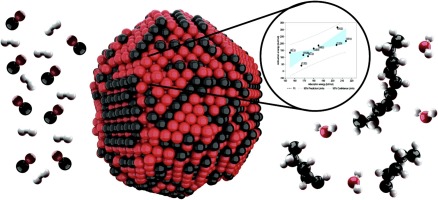Catalysis Today ( IF 5.3 ) Pub Date : 2019-02-11 , DOI: 10.1016/j.cattod.2019.02.015 Robin J.P. Broos , Bart Klumpers , Bart Zijlstra , Ivo A.W. Filot , Emiel J.M. Hensen

|
Spin-polarized density functional theory was employed to determine the preferred CO bond dissociation mechanism on low-index Miller surfaces of ϴ-Fe3C in the context of Fischer-Tropsch synthesis. Compared to the most reactive (111) surface of bcc-Fe on which CO binds in a 7-fold coordination, CO prefers to locate in 3-fold or 4-fold sites on the carburized surfaces due to the presence of interstitial C atoms at or below the surface. An important finding is that the lowest activation energies for direct CO bond dissociation are associated with the presence of step-like sites, similar to the case of metallic surfaces. We could identify such sites for 3 out of the 9 investigated surfaces, namely the (111), , and (010) terminations of ϴ-Fe3C. On the other hand, H-assisted CO dissociation is preferred on the , (001), and (100) surfaces. The other (011), (110), and (101) surfaces are inert with CO dissociation barriers close to or exceeding the CO adsorption energy. A kinetic analysis shows that the (111) surface (direct CO dissociation) and the () surface (H-assisted CO dissociation via HCO) display comparable CO bond dissociation rates, much higher than the rates computed for the other surfaces. Together these two surfaces make up ca. 28% of the surface enclosing a Wulff nanoparticle of ϴ-Fe3C. Using an atomic population analysis, we show that the activation barrier for C-O bond dissociation correlates well with the bond order of adsorbed CO. This implies that pre-activation of CO is important for lowering the overall activation barrier. The present work demonstrates that the high-temperature ϴ-Fe3C phase is highly active towards CO bond dissociation, which is the essential first step in the Fischer-Tropsch reaction. Several of the exposed surfaces present lower overall CO dissociation barriers than α-Fe (known to be unstable under Fischer-Tropsch conditions) and the χ-carbide of Fe (usually assumed to be the most stable phase of Fe-carbide under Fischer-Tropsch conditions). Notably, the activity of the (111) surface is higher than that of a stepped cobalt surface.
中文翻译:

ϴ-Fe 3 C在低指数Miller平面上CO离解机理的量子化学研究
自旋极化密度泛函理论被用来确定费-托合成背景下ϴ-Fe 3 C的低指数米勒表面上优选的CO键解离机理。与CO以7倍配位结合的bcc-Fe最具反应性的(111)表面相比,由于在C处存在间隙C原子,CO倾向于位于渗碳表面的3倍或4倍位置或表面以下。一个重要的发现是,与金属表面的情况类似,直接CO键解离的最低活化能与台阶状位点的存在有关。我们可以在9个调查表面中的3个(111个)中找到此类位置,,和(010)ϴ-Fe 3 C的末端。,(001)和(100)曲面。(011),(110)和(101)的其他表面是惰性的,且CO解离势垒接近或超过CO吸附能。动力学分析表明(111)表面(直接CO解离)和表面(通过HCO进行H辅助的CO分解)显示出可比的CO键解离速率,远高于其他表面计算出的速率。这两个表面共同构成了约。28%的表面包裹着ϴ-Fe 3 C的Wulff纳米颗粒。使用原子种群分析,我们发现CO键解离的活化势垒与吸附的CO的键序密切相关。这意味着CO的预活化对于降低整体激活壁垒很重要。目前的工作表明高温ϴ-Fe 3C相对CO键解离具有很高的活性,这是费托反应中必不可少的第一步。几个暴露的表面的总CO解离势垒比α-Fe(在费-托条件下不稳定)和Fe的χ-碳化物(通常被认为是Fischer-Tropsch下Fe-碳化物最稳定的相)低。情况)。值得注意的是,(111)表面的活性高于阶梯状钴表面的活性。



























 京公网安备 11010802027423号
京公网安备 11010802027423号